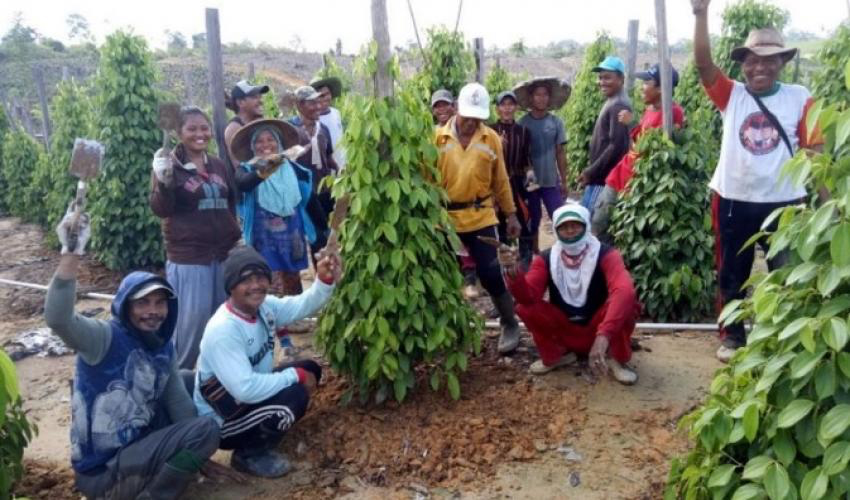Mobilising actors to create more sustainable agriculture value chains
Sustainable agriculture can benefit nature and biodiversity, increase product value and empower agricultural communities. The challenge, however, is how to get farmers and vendors — and all the different stakeholders in the agriculture value chain — to adopt more environment-friendly practices.
 Behaviour change is difficult, very, very difficult,” says Dulce Espelosin, a senior trainer for the NGO Rare, an IUCN Member. She recently shared the organisation’s theory of change in a webinar, “Working with the agriculture sector to enhance nature,” which was hosted by IUCN’s BioBiz Exchange initiative.
Behaviour change is difficult, very, very difficult,” says Dulce Espelosin, a senior trainer for the NGO Rare, an IUCN Member. She recently shared the organisation’s theory of change in a webinar, “Working with the agriculture sector to enhance nature,” which was hosted by IUCN’s BioBiz Exchange initiative.
Rare’s approach consists of pinpointing a conservation goal, identifying the threats, understanding what behaviour change is needed and the barriers to that change, e.g. are they political, economic, social? Fostering interpersonal communication and peer-to-peer exchange is an important step, as is identifying the specific attitudes that need to shift and the information that can help support the change required to achieve the desired conservation outcome.
In addition to the standard rules and regulations, material incentives and information, Dulce noted that Rare’s behavioural change toolkit included three other key elements:
1. Know the decision-making approach of your audience; are they more rational and stimulated by data, or more emotional and moved by striking messages?
2. Understand that we are social animals, therefore be cognizant of the circle of influence of your audience; who are they more likely to listen to and can you get these people on your side to incorporate your solution in the decision-making process?
3. Create a context in which you go to your audience, to help make them feel comfortable and more in control.
To put this into context, two PANORAMA case studies were presented.
Behavior change for agriculture: working with Ecuadorian farmers for better delivery and communication
In the first case study, presented on behalf of Canopy Bridge (a global network that connects producers and buyers of natural products), Dulce shared how a group of Ecuadorian farmers were facing obstacles due to the quality of their cacao beans’ delivery. Canopy Bridge worked with them to change their behaviour and improve their results. The ultimate behaviour change goal was for the farmers to grow their produce organically, in a timely manner. To better tailor their solution, Canopy Bridge reached out directly to their target audience, visiting the farmers and listening to their needs.
The proposed solutions consisted of trainings focused on diversified and organic crop production, as well as working with ancestral techniques, and native seeds, to anchor the activity within the community. Additionally, Canopy Bridge emphasized the importance of logistical efficiency, ways to make the processes more hygienic and visually appealing, and better communication flows with the buying companies. With a greater understanding of their audience, Canopy Bridge made their approach emotionally appealing with the use of painted murals and puppet shows performed by children of the community. Ultimately, these actions led to farmers using agro-ecological systems with native seeds, which in turn helped maintain the biodiversity and ecosystems.
Sundrying wild Ethiopian coffee: a recipe for forest health and good marketing
Karin Allgoewer from GIZ presented the second case study based on a GIZ project that supports the Ethiopian government and farmers to sustainably use forest products that can help conserve nature. One of the main outcomes was the development of a strategic alliance between GIZ and Original Food, a private company based in Germany, to support the production and export of wild coffee in Ethiopia. Since wild coffee grows naturally in the forest, which in this instance was part of two Biosphere Reserves (Kafa and Sheka), its sustainable harvest allows the forest to regenerate. Even though wild Ethiopian coffee has a strong local market, it did not have a good international reputation because its quality was affected by the fact that producers would dry it on the forest floor.
GIZ and the private company worked with the coffee producers to develop a simple technique of sun drying the coffee on drying beds, to increase its quality for the German market. Farmers were also trained in harvest and post-harvest improved techniques.
As Karin explained, this project created an impactful story: it was providing coffee handpicked and sun-dried by Ethiopian farmers in a biosphere reserve. Moreover, the coffee is now certified, which increases its competitiveness further.
During the webinar, the presenters received questions on measuring the environmental benefits of organic agriculture; and, helping government authorities, businesses and farmers realize the improvement in ecosystem services as a result of organic agriculture. Dulce emphasised the Ecuadorian farmers’ reclaiming of ancestral and native seeds was an incentive for businesses to embrace adaptation.
Further information
These are only two of more than 60 PANORAMA Solutions related to agriculture and biodiversity. You can search the PANORAMA platform to learn more about many other inspiring and actionable solutions. If you would like more information about this webinar, listen to the full recording here or email: BioBiz@iunc.org.
The next IUCN-PANORAMA webinar will take place in December and will focus on mobilizing finance for conservation. Finally, please share your experiences with others by adding your own solutions to PANORAMA using this link.

